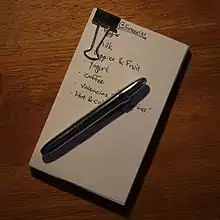
The Hipster PDA is a paper-based personal organizer, popularized by Merlin Mann in 2004.[1] Originally a tongue-in-cheek reaction to the increasing expense and complexity of personal digital assistants (PDA), the Hipster PDA (said to stand for "Parietal Disgorgement Aid" and often abbreviated to "hPDA") comprises a sheaf of index cards held together with a binder clip. Following widespread coverage in the media[2][3] and blogs, the hPDA became a popular personal management tool, particularly with followers of David Allen's Getting Things Done methodology.[4][5]
Although it began as a joke, or perhaps a statement about technology fetishism, the Hipster PDA has rapidly gained popularity with serious users,[6] with hundreds posting pictures of their customized hPDAs on photo sharing sites and exchanging tips on Internet mailing lists. Advocates of the hPDA claim that it is a cheap, lightweight, freeform organizer[7] that does not need batteries and is unlikely to be stolen. Enthusiasts also design and share index-card-size printable templates for storing contacts, to-do lists, calendars, notes, project plans, and so on.[6]
A Hipster Nano PDA uses business cards with blank backs and one that has a calendar on the back.[8]
See also
References
- ↑ Mann, Merlin (3 September 2004). "Introducing the Hipster PDA". 43 Folders.
- ↑ Musgrove, Mike (17 July 2005). "This Retro PDA Doesn't Need Batteries". The Washington Post.
- ↑ Ho, Leon (29 September 2005). "Who needs a PDA when I've got paper?". The Guardian.
- ↑ Dickerson, John (1 October 2009). "The list is life: finding a new way to manage my day". Slate.
- ↑ Newport, Cal (17 November 2020). "The Rise and Fall of Getting Things Done". The New Yorker.
- 1 2 "Hipster PDA Tips for People Obsessed With Productivity Pr0n But Bad At Actual Productivity". Slow Burn Productions. 15 July 2006.
- ↑ "Card Sharp". The Guardian. 23 June 2005. Archived from the original on 27 January 2009.
- ↑ Ho, Leon (17 October 2006). "How to make the Hipster nano PDA". lifehack.org.